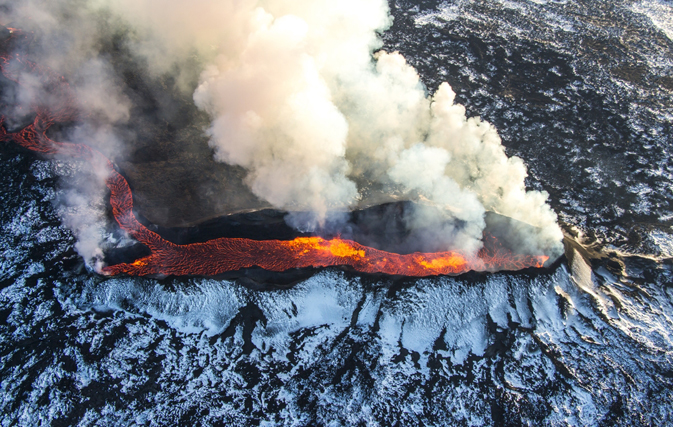ANCHORAGE, Alaska — The activity level of an Alaska volcano has declined after the mountain erupted with a massive ash cloud that prompted the cancellation of dozens of flights.
The U.S. Geological Survey said in a news release late Monday night that the intensity of the eruption had “declined significantly.”
Pavlof Volcano, one of Alaska’s most active volcanoes, is 625 miles southwest of Anchorage on the Alaska Peninsula, the finger of land that sticks out from mainland Alaska toward the Aleutian Islands.
The volcano in the 8,261-foot mountain erupted about 4 p.m. Sunday, spitting out an ash cloud that rose to 20,000 feet.
Lightning over the mountain and pressure sensors indicated eruptions continued overnight Sunday. By 7 a.m. Monday, the ash cloud had risen to 37,000 feet and winds to 50 mph or more had stretched it over more than 400 miles into interior Alaska.
“It’s right in the wheelhouse of a lot of flights crisscrossing Alaska,” said geologist Chris Waythomas, of the U.S. Geological Survey, part of the Alaska Volcano Observatory, along with the University of Alaska and the state Division of Geological and Geophysical Surveys.
In its statement late Monday, the USGS said that the volcano’s activity decline began around noon Monday and that by late at night a continuous emission was no longer being observed by satellite.
Consequently, a volcano alert — that had been at its highest level, warning of hazards both in the air and on the ground — was downgraded from a warning to a watch.
But the agency said that a significant eruption was still possible.
Earlier in the day, Alaska Airlines said it cancelled 41 flights affecting about 3,300 customers heading to Fairbanks, Bethel, Kotzebue, Nome, Barrow and Deadhorse. The airline said it will resume its 54 regularly scheduled flights on Tuesday if conditions improve.
Volcanic ash is angular and sharp and has been used as an industrial abrasive. The powdered rock can cause a jet engine to shut down. USGS geologists have compared it to flying into a sand blaster.
An eruption of Mount Redoubt in December 1989 sent out an ash cloud 150 miles that flamed out the jet engines of a KLM flight carrying 231 passengers to Anchorage. The jet dropped more than two miles before pilots were able to restart the engines and land safely.
“We just simply will not fly when ash is present,” Alaska Airlines spokeswoman Bobbie Egan said.
Waythomas had received no reports of ash falling in communities. The closest community, Cold Bay, is 37 miles southwest of the volcano, opposite of where the wind was blowing ash.
Geologists call Pavlof an open-system volcano, Waythomas said.
“The pathways that magma follows to the surface are pretty open in a volcanological sense,” Waythomas said. “They can convey magma and gas very easily. Magmas can move to the surface whenever they feel like it, more or less.”
The movement comes with little shaking of the ground, and the lack of earthquakes as an early warning of an eruption “makes us go crazy monitoring them,” Waythomas said.
The volcano, about 4.4 miles in diameter, has had 40 known eruptions. Its conical, nearly symmetrical shape indicates its eruptions tend to be less violent than the kind that blows tops off mountains.
“It can erupt for periods of hours to days or it can go on for much longer periods of time,” Waythomas said. “It won’t erupt continuously for many months or a year. It will be intermittent. But the eruption cycle could go on for a while, or it could abruptly shut off and be done tomorrow.”
